Complete Solutions to EXERCISE of chapter BIOMOLECULES of Class 11 book with complete answers and questions
| Class 11 | BIOLOGY |
| Chapter | BIOMOLECULES |
| MAXIMUM PUBLICATION | EXERCISE |
| Number Of Questions | 100 |
| Academic Year | 2023-24 |
Many elements are found in living organisms either free or in the form of compounds. One of the following is not found in living organisms.
View SolutionAminoacids, as the name suggests, have both an amino group and a carboxyl group in their structure. In addition, all naturally occurring aminoacids (those which are found in proteins) are called L-aminoacids.From this, can you guess from which compound can the simplest aminoacid be made?
View SolutionWhen we homogenise any tissue in an acid the acid soluble pool represents
View SolutionMany organic substances are negatively charged e.g., acetic acid, while others are positively charged e.g., ammonium ion. An aminoacid under certain conditions would have both positive and negative charges simultaneously in the same molecule. Such a form of aminoacid is called
View SolutionSugars are technically called carbohydrates, referring to the fact that their formulae are only multiple of `C(H_2O)`. Hexoses therefore have six carbons, twelve hydrogens and six oxygen atoms. Glucose is a hexose.Choose from among the following another hexose.
View SolutionFill the gap :- Inhibition of succinic dehydrogenase by Malonate is an example for ____
View SolutionName the phospholipid found in cell membrane.
View SolutionThe metabolic pathway from glucose to lactic acid which occurs in 10 metabolic steps is called ____
View SolutionEnergy currency in living systems is ____
View SolutionFind the odd one out. Rubber, Amino Acids, Drugs, Pigments
View SolutionArrange the following Carbohydrates in the order of increasing complexity of chemical structure. Glucose, Oligosaccharides, Lactose, Starch.
View SolutionOne full turn of the DNA double helix would involve.
View SolutionMatch the column A with B and C.

View SolutionAdd suitable word in the gap. a)A protein molecule is a polymers of __ b)Nucleic acids are polymers of .............. c)DNA has ....... instead of uracil.d)Single stranded structure is found in ___
View SolutionThe structure of amino acids in solutions of different PH are given above. Identify the structure 'B'.

View Solution`CO_2 + H_2O rarrH_2CO_3` Name the enzyme catalyse this reaction
View SolutionObserve the table and fill the blanks from the brackets (Collagen, Cholesterol, chitin, Lecithin)

View SolutionBuilding blocks of proteins are amino acids and that of polysaccharides are monosaccharides. Many polysaccharides are called homopolymers but all proteins are known as heteropolymers. a) Do you agree with the above statement? Give reason.
View SolutionBuilding blocks of proteins are amino acids and that of polysaccharides are monosaccharides. Many polysaccharides are called homopolymers but all proteins are known as heteropolymers. b) Give one example for a homopolymer.
View SolutionClassify the following as polypeptide and polysac charide.(Insulin, Glycogen, Chitin, Paper)
View Solution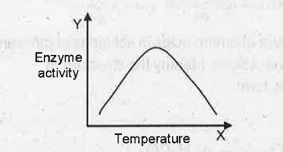 Observe the graph and comment.
Observe the graph and comment.
View SolutionList out the factors which influence enzyme activity
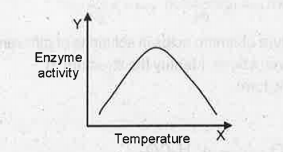
View SolutionWrite the general names of the following a) Enzymes catalyzing the linking together of two compounds
View SolutionWrite the general names of the following b) Enzymes that catalyze removed of groups from substrates by mechanism other than hydrolysis leaving double bonds.
View SolutionFind out the differences between DNA and RNA and fill the table given below.
View SolutionTwo polymers are given. In this chain how are mono mers linked ?

View SolutionThe following graph shows the relationship between subtrate concentration and rate of enzymatic reaction. What is the effect of subtrate concentration on rate of reaction ? And identify A.
View SolutionThe following graph shows the relationship between subtrate concentration and rate of enzymatic reaction. What is the effect of subtrate concentration on rate of reaction ? And identify A.
View SolutionIdentify the class of enzyme which catalyse the following reaction
View SolutionA portion of DNA double helix is given below. Copy the diagram and make correction if any.
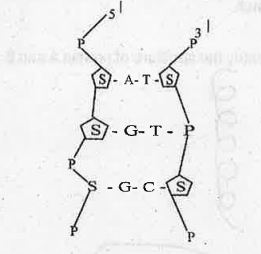
View SolutionAdenine Guanine, thymine, Cytosine, Uracil, are the nitrogen bases present in the living organisms. Write their nucleosides and nucleotides.
View SolutionPrepare a graph showing the action of temperature on enzyme activity
View SolutionWhat is optimum temperature ?
View SolutionIf we add more substrate after reaching Vmax What will be the effect in the reaction rate ?
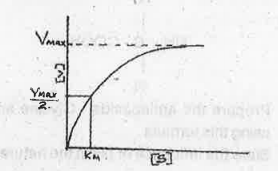
View SolutionThe table shows the percentage composition of different elements of a living matter and a non living matter represented as X and Y. Identify X and Y.

View SolutionFatty acids could be saturated or unsaturated. Give an account on it.
View SolutionIdentify the structure.
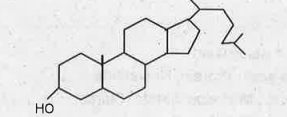
View SolutionGeneral Formula of amino acid is given below.
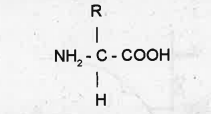 Prepare the aminoacids - Glycine and Serine using this formula
Prepare the aminoacids - Glycine and Serine using this formula
View SolutionGeneral Formula of amino acid is given below. State the influence of pH in the nature of amino acid.
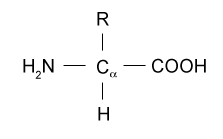
View SolutionChemical structure of an Amino acid is given.
 Prepare its Zwitter lonic form.
Prepare its Zwitter lonic form.
View SolutionChemical structure of an Amino acid is given.
 What happens to the Zwitter lon if it is placed acidic medium?
What happens to the Zwitter lon if it is placed acidic medium?
View SolutionWrite the missing word. Amino acid Protein, Nucleotide:…..
View SolutionWrite the missing word.Glucose Monosaccharide, Starch:….
View SolutionWrite the missing word.Adenine : Thymine, Guanine:…..
View SolutionWrite the missing word.Animals: Glycogen. Plants:…..
View SolutionWrite an example for a protein with quatemary structure.
View SolutionProteins carry out many functions in living organisms. List them. Sorme protein functions as enzymes
View SolutionGive an example for the following Phospholipids
View SolutionGive an example for the following Saturated fatty acid
View SolutionGive an example for the following Nucleoside
View SolutionGive an example for the following Nucleotide
View SolutionB-DNA is the most common DNA. Write the salient features of this DNA.
View SolutionIdentify the structure.
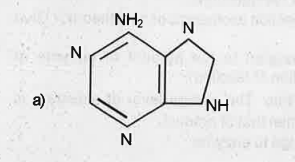
View SolutionIdentify the structure.

View SolutionThe given structure showing the molecule give ready energy for biological activities. Identify the structure.
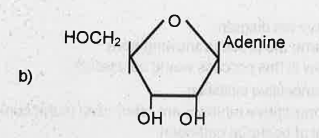
View SolutionA portion of DNA double helix is given below. Copy the diagram and make correction if any.

View SolutionClassify the given terms into two columns and give appropriate headings. rubber, Glucose, amino acids, drugs, gums, spices,cholesterol, Fatty acids
View SolutionProgress of a chemical reaction and potential energy changes associated with it is plotted as curve.
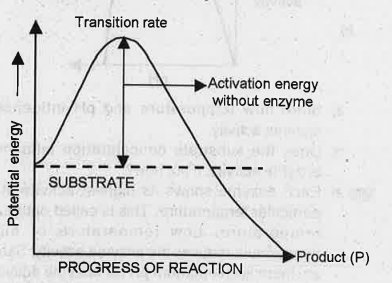 What happens to the activation energy of the substrate, when enzyme is added to the reaction system?
What happens to the activation energy of the substrate, when enzyme is added to the reaction system?
View SolutionProgress of a chemical reaction and potential energy changes associated with it is plotted as curve.
 What happens to the activation energy of the substrate, when enzyme is added to the reaction system?
What happens to the activation energy of the substrate, when enzyme is added to the reaction system?
View Solution Observe the graph and comment.
Observe the graph and comment.
View SolutionObserve the given graph a and b.
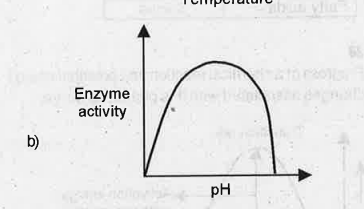 Does the substrate concentration influence enzyme activity. If so, how?
Does the substrate concentration influence enzyme activity. If so, how?
View SolutionThe graph shows the relation between potential energy and progress of reaction. Observe the graph and answer the questions. What happen to the amount of enzyme at completion of reaction?
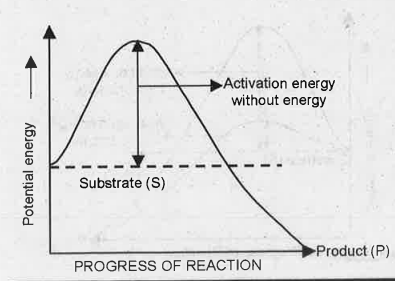
View SolutionFill in the blank columns with the correct terms/sentences.

View SolutionStructure of a nucleotide pair in DNA is showing below. Identify the bonds A, B and C.

View SolutionGive examples. Prosthetic group
View SolutionGive examples.Co-enzyme
View SolutionGive examples. Metal ion required for enzyme activity.
View SolutionGive one word The nucleic acids that behave like enzymes
View SolutionGive one word The organic compound tightly bound to the apo enzyme.
View SolutionGive one word The non protein organic compound that are not tightly bpund to the apoenzyme.
View SolutionGive one word The protein portion of the enzyme.
View SolutionIdentify the bonds marked A,B and C.

View SolutionObserve the structure. Identify the bond formed between amino acids.

View SolutionObserve the structure.How many types of amino acids are present in animal body?
View SolutionObserve the structure. In nutrition some amino acids are required. Write a note on it.
View SolutionGive name The most abundant protein in animal.
View SolutionGive name The most abundant protein in the whole of the biosphere
View SolutionGive name A polymer of fructose.
View SolutionGive name - Paper made from plant pulp is......
View SolutionGive name Complex polysaccharide present in the exoskeleton of Arthropods
View SolutionGive name - Polysaccharide with helical structure
View Solution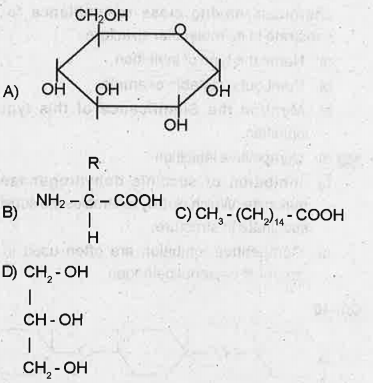 Identify the structures A, B, C and D.
Identify the structures A, B, C and D.
View SolutionName the molecule formed by the esterification of one 'D' molecule and three 'C'molecule.
View SolutionMatch the column A and B.

View SolutionThe activity of the enzyme is inhibited by certain chemicals having close resemblance to the substrate in its molecular structure. Name the type of inhibition
View SolutionThe activity of the enzyme is inhibited by certain chemicals having close resemblance to the substrate in its molecular structure. Point out a suitable example
View SolutionThe activity of the enzyme is inhibited by certain chemicals having close resemblance to the substrate in its molecular structure. Mention the Significance of this type of Inhibition.
View SolutionThe figure shows the bonding of a biomolecule. Identify the monomer

View SolutionThe figure shows the bonding of a biomolecule. Name the bond between the molecules

View SolutionThe figure shows the bonding of a biomolecule. Name the macromolecule formed

View SolutionName the macromolecule formed
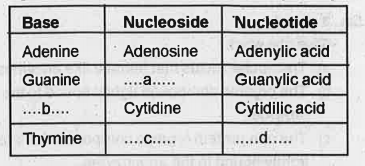
View SolutionGive one word The protein portion of the enzyme.
View SolutionNon protein constituents called cofactors are bound to the enzyme to make the enzyme catalytic activity. What happens to the catalytic activity when the cofactor is removed from the enzyme ?
View SolutionNon protein constituents called cofactors are bound to the enzyme to make the enzyme catalytic activity. Mention any two kinds of cofactors with examples
View SolutionThe breakdown of biomacromolecules in the duode num is mentioned below. Fill the blank boxes with correct terms.

View SolutionThe breakdown of biomacromolecules in the duode num is mentioned below. Fill the blank boxes with correct terms.

View SolutionThe breakdown of biomacromolecules in the duode num is mentioned below. Fill the blank boxes with correct terms.

View SolutionThe breakdown of biomacromolecules in the duode num is mentioned below. Fill the blank boxes with correct terms.

View Solution Identify the structures A, B, C and D.
Identify the structures A, B, C and D.
View SolutionName the molecule formed by the esterification of one 'D' molecule and three 'C'molecule.
View Solution
EXERCISE questions and complete solutions for chapter BIOMOLECULES of MAXIMUM PUBLICATION of Class 11